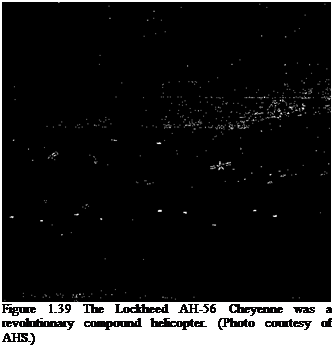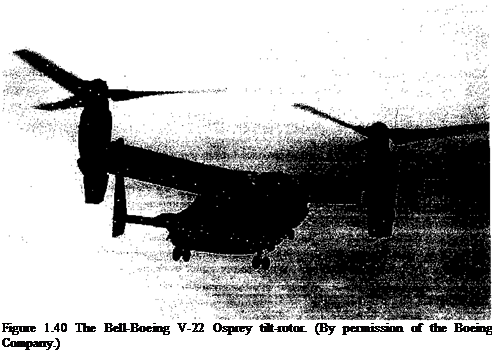Compounds, Tilt-Wings, and Tilt-Rotors
The conventional helicopter is limited in forward flight performance by the aerodynamic lift and propulsion limitations of the main rotor. These rotor limits arise because of compressibility effects on the advancing blade, as well as stall on the retreating blade (see page 57). In addition, the relatively high parasitic drag of the rotor huh and other airframe components leads to a relatively poor overall lift-to-drag ratio of the helicopter (less than 6). This generally limits performance of conventional helicopters to level-flight cruise speeds in the range of 150 kts (278 km/h; 172 mi/li), with dash speeds up to 200 kts (370 km/h; 230 mi/h) and unrefueled ranges of less than 500 miles. Although somewhat higher flight speeds are possible with compound designs, which use auxiliary propulsion devices and wings to offload the rotor, this is always at the expense of much higher power required and fuel bum than would be necessary with a fixed-wing aircraft of the same gross-weight and cruise speed. One example of a revolutionary compound helicopter was the Lockheed AH-56 Cheyenne, which was built in 1969 – see Fig. 1.39. This machine used both lift compounding with a wing and propulsion compounding using a pusher propeller. It flew at over 220 kts (407.77 km/h; 253.4 mi/h). It did not, however, go into production – see Forman (1996).
 |
 |
The need for an aircraft that could combine the benefits of a vertical takeoff and landing (VTOL) capability with the high speed cmise of a fixed-wing aircraft has led to the evolution of tilt-wing and tilt-rotor concepts. A good history of the many VTOL designs, including tilt-wings and tilt-rotors, is given by Hirschberg (1997). However, this potential capability
comes at an even greater price than for either a conventional or compound helicopter, including increased mechanical complexity, increased weight and the susceptibility for the rotors and wing to exhibit various aeroelastic problems.
The tilt-wing is basically a convertiplane concept, but it never became a viable rotating – wing concept to replace or surpass the capabilities of the helicopter. The idea is that the wing can be tilted from its normal flying position with the propellers providing forward thrust, to a vertical position with the propellers providing vertical lift. Several companies seriously considered the tilt-wing concept in the 1950s, with Boeing, Hiller, Vought-Hiller – Ryan (later Ling-Temco-Vought) and Canadair all producing flying prototype aircraft. The Vertoi VZ-2 first flew in 1957 and went on to make many successful conversions from hover into forward flight. However, the unsteady airloads produced by airflow separation on the wing as it stalled during conversion flight resulted in some difficult piloting and these issues were never satisfactorily resolved. The Hiller X-18 was a large tilt-wing aircraft compared to the VZ-2. The aircraft used two large diameter counterrotating propellers (used from the earlier Ryan Pogo concept) – see Straubel (1964). The aircraft underwent flight testing in 1960, but never did make a full conversion. The program was canceled in 1961 after the aircraft suffered a loss of control. In the 1980s, the Ishida Company developed the TW-68 tilt-wing aircraft as a private venture, but the company went into bankruptcy before the aircraft could be built.
The tilt-rotor aircraft takes off and lands vertically with the rotors oriented like a helicopter. For forward flight, the wing tip-mounted rotors are progressively tilted to convert the aircraft into something that looks like a fixed-wing turboprop airplane. In this mode, the tilt-rotor is able to achieve considerably higher flight speeds (about 300 kts; 555 km/h; 344 mi/h) than would be possible with a helicopter. Therefore, the tilt-rotor combines some attributes of the conventional helicopter with those of a fixed-wing aircraft. During WW2, the Focke Achgelis Fa 269 was proposed as a tilt-rotor. The side-by-side rotors pointed downward for takeoff and then rotated aft to provide propulsion in normal flight with conventional wings providing lift. However, the aircraft remained a paper project. A practical tilt-rotor concept was first demonstrated in a joint project between the Transcendental Aircraft Corporation and Bell in 1954. Various technical problems were encountered with the first aircraft, the Model 1 – G, especially in the conversion from helicopter mode to fixed-wing flight. Bell later led the development of the XV-3 in 1951, which had two fully articulated three-bladed rotors. The XV-3 was damaged in an accident in 1956 after an aeroelastic problem with the rotor. The second XV-3 used a two-bladed teetering rotor system and the aircraft was successfully flown in 1958. However, several aeromechanical problems were again encountered, including pylon whirl flutter.
By the late 1960s, Bell had developed the Model 266 tilt-rotor and later the Model 300. Various wind-tunnel tests of scaled models led to an improved understanding of the rotor and wing aeroelastic issues involved with tilt-rotors, especially during the conversion mode and Bell continued to develop the Model 301, This aircraft later became the XV-15, which demonstrated the viability of the tilt-rotor concept. The XV-15 was purely experimental and never designed for production, and flew experimentally through 2003. However, in 1983 the much larger V-22 Osprey tilt-rotor program was begun (see Fig. 1.40). This joint Bell-Boeing project has resulted in several test and preproduction aircraft and in 1997 the decision was made to put the aircraft into production for the US Marines, Navy, and Air Force. As of 2005, however, it was still in the developmental stage with low rate production. Because the rotors of a tilt-rotor cannot be as large as those of a helicopter, the hovering efficiency of the tilt-rotor is not as good as that of a helicopter. In the design of the Bell – Boeing V-22 Osprey, the rotor diameter was also limited by the need to operate and hangar
the aircraft on board an aircraft carrier. The tilt-rotor, however, has the ability to fly much faster than a conventional helicopter.
The Agusta-Bell Model 609 civilian tilt-rotor first flew in 2003 and will be capable of transporting 9 passengers at 275 kts (509 km/h; 315 mi/h) over 750 nm (1,390 km; 860 mi) sectors. It is expected to be certified in 2007. See Bell Helicopter Textron (2005) for further information. The Europeans too have embarked on fundamental research toward a civil tilt-rotor program suited to scheduled passenger transport. The project is being undertaken by a consortium of twelve partners representing five European nations. The ultimate aim is to develop a 19-seat, twin-engine tilt-rotor aircraft that can be flown by a single pilot to be sold to airlines and corporations. While the work is expected to culminate in the first flight of the new tilt-rotor aircraft in 2008, the lengthy half-decade-long development of the American tilt-rotor program suggests that realistically the flights of a European tilt-rotor may be further away than this. The success of any civil tilt-rotor program, European or American, may be tied to the ultimate success or otherwise of the V-22 Osprey.
![]()
 |
РІіапІлг D airinnr V’liapiVl JLXV’TAVTT
During the past sixty years since the first successful flights, helicopters have matured from noisy, unstable, rickety vibrating contraptions that could barely lift the pilot and a small payload into sophisticated machines of quite extraordinary capability. Igor Sikorsky’s dream has certainly been fulfilled, perhaps in many ways that he could not have possibly imagined. At the beginning of the twenty-first century, there were about 40,000 helicopters flying worldwide. Its roles encompass air ambulance, sea and mountain rescue, police surveillance, corporate services and oil rig servicing in the civilian world and troop transport and antitank gunships in military use. In rescue operations alone, the helicopter
has saved the lives of well over a million people. The helicopter today is a safe, versatile, and reliable aircraft and it will continue to be an indispensable part of modern life well into the twenty-first century.
The improved design of the helicopter and the increasing viability of other vertical lift aircraft such as the tilt-rotor continue to advance as a result of the revolution in computer – aided design and manufacturing and the advent of new lightweight composite materials. Sustained scientific research and development in many aeronautical disciplines has allowed for dramatic increases in helicopter performance, overall lifting and cruise efficiencies, and excellent mechanical reliability. Continuous aerodynamic improvements to rotor efficiency
Kni m ПІ1/МІГЛ/1 fli л ліі л t/л I – i ft n «л ілтгі /лп /4 tU«t m tv» /Л»*а tlv n «л ttr /vtv»»-»tt т fir/vt/vlvt ntv/4 – t-л
navu anuwLu mw liuiivupiui tv nit a pa^iuau uiat 10 mutt шсш на auu tv
fly in level flight at speeds in excess of 200 kts (370 km/h; 229 mi/h). Since the 1980s, there has been an accelerating scientific effort to understand and overcome some of the most difficult technical problems associated with helicopter flight, particularly in regard to aerodynamic limitations associated with the main rotor. In more recent years, however, increases in the capabilities of helicopters has been much more incremental, despite major advances in understanding using various types of computational aerodynamic methods and experimental measuring techniques. While future gains in performance will certainly be attained, the immediate need for more capable, efficient, safer, and economic helicopters centers on the ability to really understand and more accurately predict its aerodynamics. This may also require the implementation of revolutionary developments to control its complex aerodynamics. Only then will the helicopter fulfill a wider variety of civilian and military roles.











